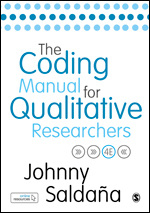Analytical memos and notes in qualitative data analysis and coding
There is a lot more to qualitative coding than just deciding which sections of text belong in which theme. It is a continuing, iterative and often subjective process, which can take weeks or even months. During this time, it’s almost essential to be recording your thoughts

There is a lot more to qualitative coding than just deciding which sections of text belong in which theme. It is a continuing, iterative and often subjective process, which can take weeks or even months. During this time, it’s almost essential to be recording your thoughts, reflecting on the process, and keeping yourself writing and thinking about the bigger picture. Writing doesn’t start after the analysis process, in qualitative research it often should precede, follow and run in parallel to a iterative interpretation.
The standard way to do this is either through a research journal (which is also vital during the data collection process) or through analytic memos. Memos create an important extra level of narrative: an interface between the participant’s data, the researcher’s interpretation and wider theory.
You can also use memos as part of a summary process, to articulate your interpretations of the data in a more concise format, or even throw the data wider and larger by drawing from larger theory.
It’s also a good cognitive exercise: regularly make yourself write what you are thinking, and keep yourself articulating yourself. It will make writing up at the end a lot easier in the end! Memos can be a very flexible tool, and qualitative software can help keep these notes organised. Here are 9 different ways you might use memos as part of your work-flow for qualitative data analysis:
Surprises and intrigue
This is probably the most obvious way to use memos: note during your reading and coding things that are especially interesting, challenging or significant in the data. It’s important to do more than just ‘tag’ these sections, reflect to yourself (and others) why these sections or statements stand out.
Points where you are not sure
Another common use of memos is to record sections of the data that are ambiguous, could be interpreted in different ways, or just plain don’t fit neatly in to existing codes or interpretations. But again, this should be more than just ‘flagging’ bits that need to be looked at again later, it’s important to record why the section is different: sometimes the act of having to describe the section can help comprehension and illuminate the underlying causation.
Discussion with other researchers
Large qualitative research projects will often have multiple people coding and analysing the data. This can help to spread the workload, but also allows for a plurality of interpretations, and peer-checking of assumptions and interpretations. Thus memos are very important in a team project, as they can be used to explain why one researcher interpreted or coded sources in a certain way, and flag up ambiguous or interesting sections for discussion.
Paper-trail
Even if you are not working as part of a team, it can be useful to keep memos to explain your coding and analytical choices. This may be important to your supervisors (or viva panel) as part of a research thesis, and can be seen as good practice for sharing findings in which you are transparent about your interpretations. There are also some people with a positivist/quantitative outlook who find qualitative research difficult to trust because of the large amount of seemingly subjective interpretation. Memos which detail your decision making process can help ‘show your working out’ and justify your choices to others.
Challenging or confirming theory
This is another common use of memos, to discuss how the data either supports or challenges theory. It is unusual for respondents to neatly say something like “I don’t think my life fits with the classical structure of an Aeschylean tragedy” should this happen to be your theoretical approach! This means you need to make these observations and higher interpretation, and note how particular statements will influence your interpretations and conclusions. If someone says something that turns your theoretical framework on its head, note it, but also use the memos as a space to record context that might be used later to explain this outlier. Memos like this might also help you identify patterns in the data that weren’t immediately obvious.
Questioning and critiquing the data/sources
Respondents will not always say what they mean, and sometimes there is an unspoken agenda below the surface. Depending on the analytical approach, an important role of the researcher is often to draw deeper inferences which may be implied or hinted at by the discourse. Sometimes, participants will outright contradict themselves, or suggest answers which seem to be at odds with the rest of what they have shared. It’s also a great place to note the unsaid. You can’t code data that isn’t there, but sometimes it’s really obvious that a respondent is avoiding discussing a particular issue (or person). Memos can note this observation, and discuss why topics might be uncomfrotable or left out in the narrative.
Part of an iterative process
Most qualitative research does not follow a linear structure, it is iterative and researchers go back and re-examine the data at different stages in the process. Memos should be no different, they can be analysed themselves, and should be revisited and reviewed as you go along to show changes in thought, or wider patterns that are emerging.
Record your prejudices and assumptions
There is a lot of discussion in the literature about the importance of reflexivity in qualitative research, and recognising the influence of the non-neutral researcher voice. Too often, this does not go further than a short reflexivity/positionality statement, but should really be a constantly reconsidered part of the analytical process. Memos can be used as a prompt and record of your reflexive process, how the data is challenges your prejudices, or how you might be introducing bias in the interpretation of the data.
Personal thoughts and future directions
As you go through the data, you may be noticing interesting observations which are tangential, but might form the basis of a follow-on research project or reinterpretation of the data. Keeping memos as you go along will allow you to draw from this again and remember what excited you about the data in the first place.
Qualitative analysis software can help with the memo process, keeping them all in the same place, and allowing you to see all your memos together, or connected to the relevant section of data. However, most of the major software packages (Quirkos included) don’t exactly forefront the memo tools, so it is important to remember they are there and use them consistently through the analytical process.
Memos in Quirkos are best done using a separate source which you edit and write your memos in. Keeping your notes like this allows you to code your memos in the same way you would with your other data, and use the source properties to include or exclude your memos in reports and outputs as needed. However, it can be a little awkward to flip between the memo and active source, and there is currently no way to attach memos to a particular coding event. However, this is something we are working on for the next major release, and this should help researchers to keep better notes of their process as they go along. More detail on qualitative memos in Quirkos can be found in this blog post article.

There is a one-month free trial of Quirkos, and it is so simple to use that you should be able to get going just by watching one of our short intro videos, or the built-in guide. We are also here to help at any stage of your process, with advice about the best way to record your analytical memos, coding frameworks or anything else. Don’t be shy, and get in touch!
References and further reading:
Chapman, Y., Francis, K., 2008. Memoing in qualitative research, Journal of Research in Nursing, 13(1). https://jrn.sagepub.com/content/13/1/68.short?rss=1&ssource=mfc
Gibbs, G., 2002, Writing as Analysis, https://onlineqda.hud.ac.uk/Intro_QDA/writing_analysis.php
Saldana, J., 2015, The Coding Manual for Qualitative Researchers, Writing Analytic Memos about Narritative and Visual Data, Sage, London. https://books.google.co.uk/books?id=ZhxiCgAAQBAJ
Saldana, J., 2021, The Coding Manual for Qualitative Researchers (4th Edition). Sage London


